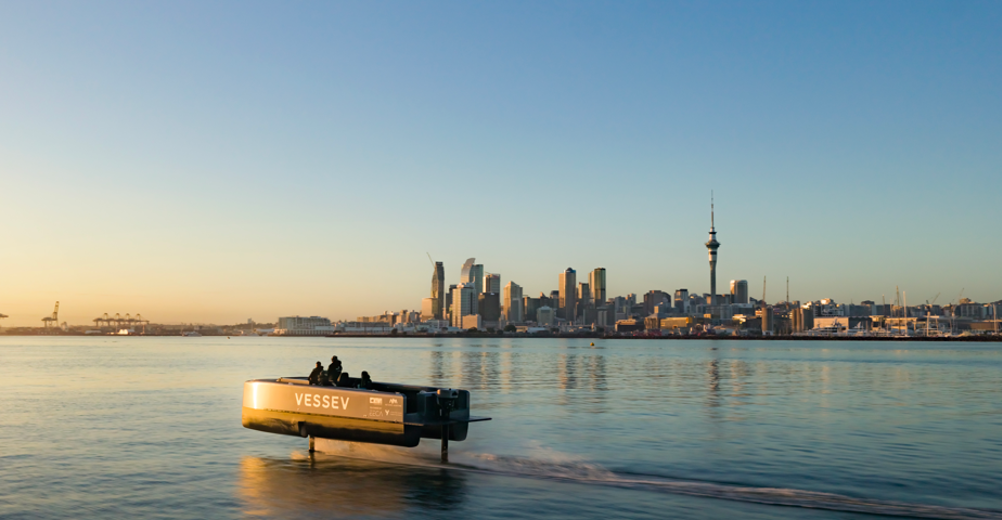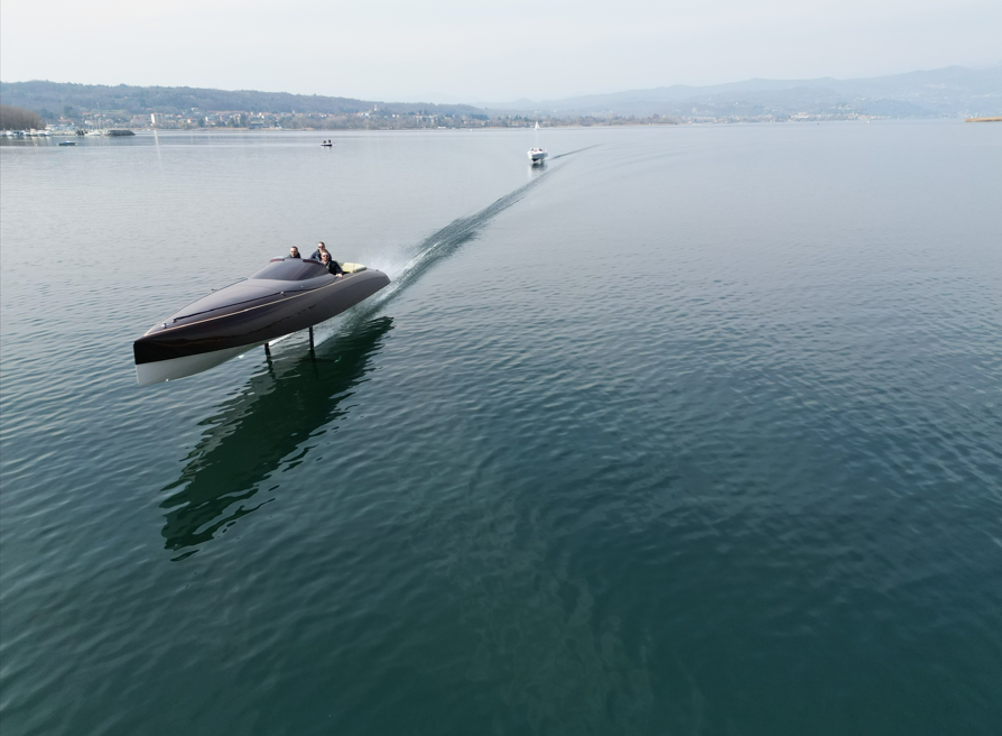Electrically-powered hydrofoiling boats are making waves around the world, with new ferry services set to get underway soon in cities such as Stockholm and Auckland. The Engineer caught up with experts from three companies leading the charge to find out what’s driving the boom and where the nascent segment is heading.
Mikael Mahlberg - Head of Comms & Test Pilot, Candela
Eric Laakmann - CEO, Vessev
Simon Schofield - CTO, BAR Technologies
Why has hydrofoiling become a breakthrough marine technology in recent years?
SS: Hydrofoiling has been about for many years, but in the past its efficiency was superseded by other technologies. However, advancements in control engineering technology, simulation, and materials means we can now build much more efficient hydrofoils, which consume much less energy. With the advent of boat electrification, and the resultant challenges around the number of batteries required, it’s important to minimise the amount of energy you’re using. A foiling boat at high speed uses 70 - 80% less energy than a traditional vessel, which goes hand-in-hand with making electric boats both highly efficient and usable.
MM: Hydrofoiling is the only way to make electric vessels with long range at high speed, as conventional hulls are too inefficient. With Candela’s hydrofoil system, we cut energy usage by 80% which enables new performance in electric boats. But by increasing the efficiency that much, we’re also enabling waterborne transport that is vastly cheaper than today’s fossil fuel vessels – crucial in incentivizing operators to switch to sustainable vessels.
So, why hasn’t hydrofoiling taken off until now? Well, first, one has to invent a foiling electric boat, which we did in 2016 – no one had done it before. A flying electric boat would have been very hard to make in the 1990’s, for example, as the tech needed – energy dense lithium-ion batteries, sensors, computers, and light weight carbon composites – were not available then. The Flight control computer and associated sensors and other electronics simply did not exist or were extremely expensive 15 years ago, and this technology has become available thanks to advancements in drone technology, electric cars and smartphones.
EL: In the case of this new breed of hydrofoiling vessels, the breakthroughs have come from three places:
America's Cup Racing Yachts: The materials and processes used to build very efficient hydrofoiling systems have become very good due to the America’s Cup. The foils themselves are more efficient and the simulation tools used to design them are incredibly good today. Whereas foils were built from expensive metals in the 1960s and 1970s, today they are built from mostly carbon fibre which is both lighter and cheaper.
Automotive Electrification: While marine is a huge industry, it is not as big as automotive. Electric cars make up 14% of new sales in 2020 and we are seeing the trickle down of low cost components into our space. This enables cost effective electric vessels which are also lightweight and performant.
Drones and Robotics: In the last 10 years, we have seen an absolute proliferation of robotic machines including drones. High performance actuation systems, mobile compute power and sensors are all getting astoundingly better and cheaper. Not only that, but the actual math for control systems is making leaps and bounds. When you consider that the Boeing 929 introduced in the year 1976 was run on analog circuits, it’s easy to see how things have developed the way they have.

Can you describe what makes your company’s approach unique?
EL: Whereas standard boat building is fairly straightforward, we have to take a totally different approach. We are fully vertically integrated. We design everything between the propeller and the helm which is the only way to make high performance electric hydrofoiling vessels. Just like cell phones today, the best experiences and performance are achieved through tight integration rather than loosely coupled modularity.
In terms of our hydrofoiling techniques, we use many of the same approaches that winning America's Cup teams use. Our hydrofoils have high precision flaps which generate a lot of lift at take-off and can react to significant wind and waves. This is harder to engineer than other techniques but results in a very performant system.
MM: First off, We’re the first and only company so far that have put foiling electric boats into serial production; we’ve manufactured around 70 vessels so far, including 30 C-7 sportsboats, 40 C-8 daycruisers and now producing our second P-12 foiling ferry. We say making a prototype is quiet easy, but getting to serial production is hard. And to make money off your serial production is even harder, but that’s a point we have now reached. And that’s very important, as we believe hydrofoiling vessels is the key to succeed with our mission to speed up the transition to fossil fuel-free lakes and oceans.
There are other upstart companies trying their hands at foiling boats, but Candela is a tech company which develops and builds most parts from scratch – from the C-POD motors to the flight control computers and carbon fibre hulls. This is a huge advantage as everything in our vessels are optimized for foiling.
SS: BAR Technologies’ approach stems from a high-performance hydrofoiling background born out of the America’s Cup. We have a strong understanding and have worked hard on maximising efficiency through building marginal gains into the systems. One of the key components of this is the control software and the continuity of our simulation approach throughout. To do so we used the same toolchain from the initial development of the foils through to the simulation of how the boat will react to the control system, development testing, and then implementation. As projects evolve, our simulation continuity gets more advanced and refined, but ultimately the end product is very efficient and reliable in terms of flight control and comfort.
What are some of the key engineering challenges with hydrofoiling?
MM: There are quite a few, which is also a reason why no one has done this at scale before. First off, an electric hydrofoiling boat is an inherently unstable vessel, which means you need to balance it by adjusting the foils’ angle of attack – something the flight controller does 100 times per second. So developing the software to keep the boat flying in different weathers and sea states was one key obstacle to overcome. Once we succeeded in this, we started to develop our own drivetrain, the Candela C-POD, a submerged , direct drive motor which is more efficient, virtually silent, needs no maintenance and is optimized for a very efficient boat. The third challenge is obviously mass production.
SS: There are two main challenges. Firstly, the flight control, which is a hard thing to do well. This ensures that the vessel is inherently safe, not just from a control point of view but also from a platform layout and architecture perspective.
Secondly, there is the challenge that to be more efficient you will need to push your materials harder, be more refined in your design and manufacturing processes, and use modern materials.

EL: It is an incredibly constrained problem with trade-offs to be made on everything. Rarely are there zero-compromise solutions on the table. We spend a lot of time working through various options for approaches to different challenges.
One example of this is our electric actuators. We did a few loops around the market for actuators and were never really happy with the outcome we were getting. In the end for the VS—9, we had to design our own actuators from scratch. Initially this felt like a bunch of extra effort for marginal gains, but we identified that we could design a common actuator for all seven systems on board that need to move and slide. This ended up increasing our performance, improving the longevity of the vessel, and reducing the build cost.
This is just one example of thousands though.
How do you see the technology and the market evolving in the years ahead?
EL: On the engineering side, I think we are going to see tighter and tighter integration of these systems. Whereas today, many of the hydrofoiling vessels are built with off the shelf components, we are going to start seeing far more bespoke solutions coming into existence.
On the market side, the reality is that there are four options for powered vessels if one were to purchase a vessel in the next five years. Fossil fuel powered vessels, conventional electric or hybrid, alternative fuels, and what we do.
What we do has the best experience, very good performance and the lowest lifetime cost of ownership of all options. While sustainable hydrofoiling vessels represent such a small fraction of boats out there today - less than 100 out of 33 million vessels worldwide - that is going to change in a big way in the coming decade.
MM: We think waterborne transport, especially in urban environments, will see a renaissance thanks to electric hydrofoiling. It can be used to unlock the full potential of our waterways, to mitigate road congestion and to provide quick shuttle traffic in many cities. Today, the waterways are mostly empty, because ships are slow (due to wake/speed restrictions) and high costs. Ships are also big polluters. In Stockholm, starting this fall, we’ll cut commuting times in half, as we’ve received an exemption from speed limits. This can definitely be the case in many other cities, and we already have several European and international customers for the P-12.
SS: We are going to see a lot of growth, both in the leisure and - probably to a lesser extent - in the commercial sectors. If you want to be operating 100% electrically off batteries and reaching high speeds, plaining speeds, it’s one of the only ways to reduce the energy consumption enough to make battery solutions viable. Batteries are very heavy compared to diesel in their energy density. Reducing the energy consumption by circa 80% makes electrification viable.












IET sounds warning on AI doll trend
I agree that we need to reduce cooling water demand for servers. And yes, generative AI consumes a large amount. But what about BitCoins? Their...